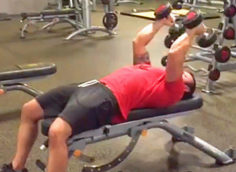New PR or Just a Shallower Squat?
So, you just hit a new back squat PR? You absolutely nailed it, right? Well, maybe. Unless you hit proper depth, you most definitely did not nail it.
We've all been guilty of shortening our squat depth just a little bit to go up in weight, but that can be a slippery slope. If you continue to cheat your depth to falsely increase your weight, you'll eventually become the douchebag who's just un-racking and re-racking the bar.
Before you become "that guy" let's learn what proper depth is and reassess your squat.
When you go to proper depth, you engage your glutes and hamstrings more, which will give you the big ol' bubble butt you want. Chicks dig good butts. Dudes dig good butts. Everybody digs good butts.
If all you do is quarter squats, you'll primarily be working the quads. This isn't a bad idea if you're a bodybuilder and want to develop your VMO. But if you have no idea what a VMO is, you have no business quarter squatting instead of full squatting.
When people don't hit depth, it's because:
- They're immobile.
- They have no idea what they're doing.
- Their ego is too big and they're embarrassed about the amount of weight they can actually squat.
None of these reasons are valid. If you're too immobile, address your mobility. If you have no clue what you're doing, read on. If you have too big of an ego, you'll get hurt. And people will laugh.
To make sure you're ready to go, check that you're doing the following:
- Stand with your feet approximately shoulder width apart. Feet should be pointing slightly out.
- Take a deep breath and brace your core as you prepare to squat.
- Push your hips back and drive your knees out during the eccentric (lowering) portion of the squat. Your heels should be firmly planted and you should be driving through your entire foot.
- Once your hips are either even with or below your knees, start the concentric (raising) portion of the squat.
- Keep your head neutral and chest up as you begin to drive out of the hole.
- Drive your hips up and forward from the bottom portion of the squat.
- Exhale as you reach a standing position.
For more details, check out Mark Rippetoe's Squat Mechanics: A Deep Analysis.
There's a lot of wiggle room between hitting an ass-to-grass squat vs. "un-racking and re-racking" the bar. The simplest way to find your proper depth is to have someone video you from the side as you squat using just the bar. You should squat down as deep as possible while maintaining a strong flat back.
Once your pelvis starts to tilt under your body (butt wink) you've gone too far. Proper depth for you is the point right before you get butt wink. This may or may not include having your knees parallel to your hips, or having your hips drop below your knees. If your butt starts to get winky before your hips are parallel to your knees, however, you should really address your mobility.



If you're able to hit a deep squat with just the bar, there's no excuse not to hit a deep squat with weight. Once you know what your proper depth is, anything short of that is either performing a "partial" or cheating.
Now, the depth you're currently at isn't necessarily the depth you'll always be at. If you get on a good mobility routine you should start to notice increases in your depth.
One of the best ways to increase your mobility on the squat is to squat more. You'd be surprised just how many people neglect performing a movement pattern in favor of overly complex stretches and buttloads of soft tissue work. I'm not saying to skip stretching or soft tissue work, but if you're trying to add some depth to your squat, then you need to squat often!
They're a good idea if you're trying to excite your nervous system to handle more weight, develop your quads, or improve your vertical jump.
But if your goal is to develop your glutes and hamstrings through a full functional motion, partial squats aren't for you.




